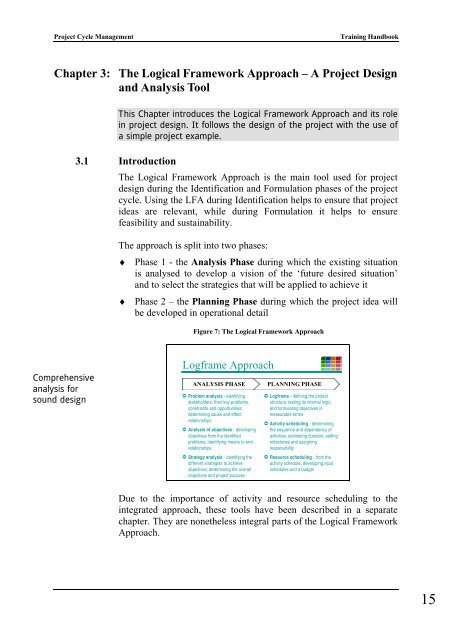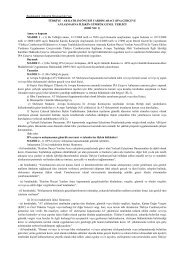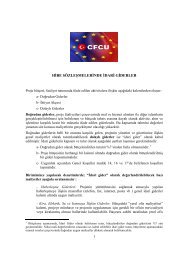Project Cycle Management Training Handbook - CFCU
Project Cycle Management Training Handbook - CFCU
Project Cycle Management Training Handbook - CFCU
You also want an ePaper? Increase the reach of your titles
YUMPU automatically turns print PDFs into web optimized ePapers that Google loves.
<strong>Project</strong> <strong>Cycle</strong> <strong>Management</strong> <strong>Training</strong> <strong>Handbook</strong><br />
Chapter 3: The Logical Framework Approach – A <strong>Project</strong> Design<br />
and Analysis Tool<br />
Comprehensive<br />
analysis for<br />
sound design<br />
This Chapter introduces the Logical Framework Approach and its role<br />
in project design. It follows the design of the project with the use of<br />
a simple project example.<br />
3.1 Introduction<br />
The Logical Framework Approach is the main tool used for project<br />
design during the Identification and Formulation phases of the project<br />
cycle. Using the LFA during Identification helps to ensure that project<br />
ideas are relevant, while during Formulation it helps to ensure<br />
feasibility and sustainability.<br />
The approach is split into two phases:<br />
♦ Phase 1 - the Analysis Phase during which the existing situation<br />
is analysed to develop a vision of the ‘future desired situation’<br />
and to select the strategies that will be applied to achieve it<br />
♦ Phase 2 – the Planning Phase during which the project idea will<br />
be developed in operational detail<br />
Figure 7: The Logical Framework Approach<br />
Logframe Approach<br />
ANALYSIS PHASE<br />
➲ Problem analysis - identifying<br />
stakeholders, their key problems,<br />
constraints and opportunities;<br />
determining cause and effect<br />
relationships<br />
➲ Analysis of objectives - developing<br />
objectives from the identified<br />
problems; identifying means to end<br />
relationships<br />
➲ Strategy analysis - identifying the<br />
different strategies to achieve<br />
objectives; determining the overall<br />
objectives and project purpose<br />
PLANNING PHASE<br />
➲ Logframe - defining the project<br />
structure, testing its internal logic,<br />
and formulating objectives in<br />
measurable terms<br />
➲ Activity scheduling - determining<br />
the sequence and dependency of<br />
activities; estimating duration, setting<br />
milestones and assigning<br />
responsibility<br />
➲ Resource scheduling - from the<br />
activity schedule, developing input<br />
schedules and a budget<br />
Due to the importance of activity and resource scheduling to the<br />
integrated approach, these tools have been described in a separate<br />
chapter. They are nonetheless integral parts of the Logical Framework<br />
Approach.<br />
15





